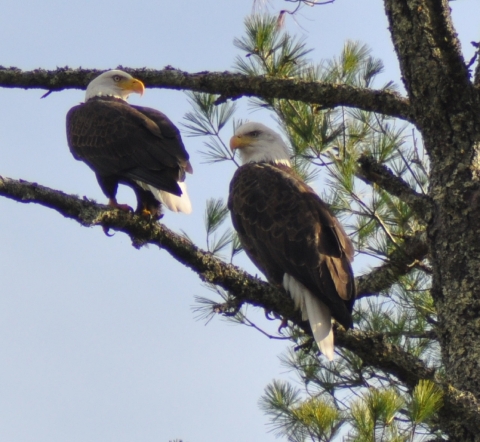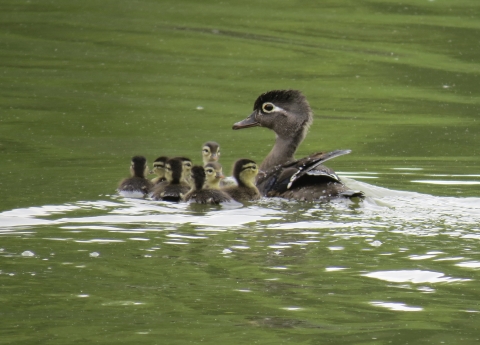Seasons of Wildlife
Bald Eagles
The Bald Eagle is a large bird of prey and the national emblem of the United States. Bald Eagles are found at Big Lake year-round. They are typically seen near large bodies of water with old growth trees nearby, which are good for nesting. Their nests are the largest of any bird species and can be up to 13 feet deep and 8 feet wide. Bald Eagles primarily eat fish, but will opportunistically eat other foods such as carrion. Although males and females physically look the same, females are usually 25 percent larger. They become sexually mature when they are 4 to 5 years old. Bald Eagle populations declined rapidly in the 1960s, and they were put on the Endangered Species List in 1978. Their populations eventually recovered, and in 1995 the Bald Eagle was removed from the Endangered Species list. Big Lake NWR served as a safe nesting area for eagles and helped their populations recover.
Wood Ducks
The wood duck is a beautiful bird that can be found on the refuge year-round. It nests in the cavities of bald cypress and other bottomland hardwood trees. Mother wood ducks will lay approximately 8 eggs in a nest and incubate them for about 25 days. After 25 days have passed, the eggs hatch and the ducklings are born. Within the first 24 hours, the ducklings jump from the tree cavity where they were born to join their mother below on dry ground or in the water. The ducklings are fully grown after 60 days and ready to fly away. Wood ducks can eat a variety of seeds, but focus on acorns and aquatic invertebrates for food. It is estimated that the refuge hatches about 2,500 ducklings a year.
Green Tree Frogs
The color of the green tree frog ranges from light to dark green. They have a white or yellow stripe that runs from the upper lip down the side of its body, and a white or yellow belly. Tree frogs have large, round adhesive toepads that help them stick to trees and other structures. Adult males are larger than females and have loose skin over their throat so it can become inflated when they make their call. They prefer permanent bodies of water such as marshes, swamps, and sloughs. Females lay between 500 and 1,000 eggs during June, usually near the water’s surface or on floating vegetation. Hatching takes place about 3 days after the eggs are fertilized, and transformation from tadpoles into froglets occurs between late June and early September.

